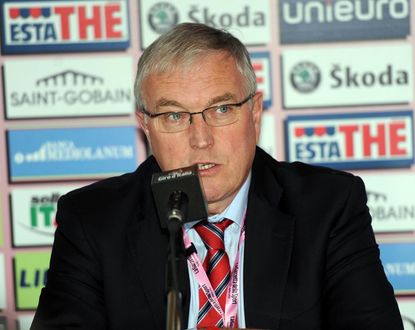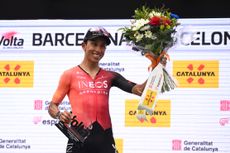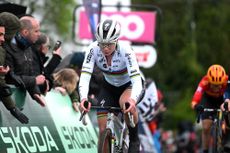McQuaid confirms Armstrong donated $100,000 to UCI

Pat McQuaid, the president of the UCI, has confirmed that Lance Armstrong made a donation of $100,000 which the governing body used to purchase a Sysmex machine, a piece of equipment used to analyse blood samples.
This contradicts the declaration made by Lance Armstrong in a deposition taken as part of the case brought by Armstrong against SCA Promotions in 2005. Then, Armstrong said he had made a payment of around $25,000 to the UCI to help fund the fight against doping.
Speaking to journalists at the Giro d'Italia, McQuaid said: "We are looking into it to be fully transparent, by the end of it we will have the full facts available. That will include the invoice of the Sysmex machine, when it was bought.
"My understanding, without having examined the full detail, is that during 2002 Lance Armstrong and Johan Bruyneel visited the UCI headquarters in Aigle [Switzerland]. It had just opened in April 2002, it was some time after that. They got a guided tour of the centre. They were impressed by what they saw and Armstrong offered $100,000 to help the development of cycling.
"The UCI decided to use the money on a Sysmex machine, my understanding is that the machine cost around $88,000. We did nothing more about this until 2005 when it was realised that the money had not been paid by Armstrong. A phone call was made and the money came in.
"I don't believe there was a conflict of interest. The machine is still in use today to test riders before major races. If there is any money left over it is still in the account of the UCI."
The issue of the donation made by Armstrong was raised again in light of his declaration that he had never paid the UCI any money. One of Floyd Landis's allegations was that Johan Bruyneel and Armstrong travelled to UCI headquarters in 2001 to make a payment to Hein Verbruggen in order to suppress a positive test for EPO. Verbruggen and Armstrong both strongly denied the allegation and the UCI says it has documentary evidence to support its claim that there was no positive test for EPO at that year's Tour of Switzerland.
Get The Leadout Newsletter
The latest race content, interviews, features, reviews and expert buying guides, direct to your inbox!
However, Armstrong did donate money to the UCI. While there is no suggestion that the payment made by Armstrong is the same one that Landis was alleging took place, it nevertheless demonstrates that Armstrong donated money to the sport's governing body while he was an active rider. Armstrong and McQuaid's recollections of how much money was donated do not match.
Cycling Weekly published an article on Sunday examining the conflicting statements by Armstrong and McQuaid surrounding the payment. A Sysmex machine is used to analyse blood to perform cell and reticulocyte counts. The UCI uses the machine to do blood tests before races.
Armstrong told CW in an interview in 2008 that the amount he had donated to the UCI was in the region of $25,000. That tallied with his testimony given to the SCA Promotions hearing.
In 2005, Armstrong challenged SCA Promotions, a sports promotion company based in Dallas, Texas, after it had withheld half of a $10m payment the rider was due for winning his sixth Tour de France in 2004.
Since 2001, Tailwind Sports, the company that owned the US Postal Service team, had purchased insurance contracts that would pay out for each of Armstrong's Tour de France victories.
SCA Promotions had paid out in 2002 and 2003 but withheld further payments because of allegations of doping laid against Armstrong. The rider has always denied doping.
An arbitration tribunal in Texas heard the case but before it ruled, SCA Promotions settled the case and paid Armstrong the unpaid amounts after a hearing.
At that hearing questions were asked about the amount and timing of a payment or payments Armstrong was believed to have made to the UCI.
Armstrong was asked about the payment in a deposition, which is a testimony taken out of court while under oath for use during the hearing. The interview took place in November 2005.
Asked if he had made a contribution or donation to the UCI, Armstrong said: "I have, yeah."
He said the payment was made "some years ago. I don't recall exactly."
When asked what the payment was for, Armstrong said it was to fund the fight against doping. Asked if there was any specific event that triggered the desire to make a donation he said: "The only event, or the only idea is that I'm in support of that fight, just like I've done on other occasions."
Asked how much he paid, Armstrong said: "I think 25,000." When pressed, he said it couldn't be in the region of 200,000 or 150,000 but was more likely in the region of 30 or 40. "I think it's no more than 30," Armstrong replied.
Armstrong was also asked if he had given money since. "I have pledged money since but I don't think I've done it yet," he said.
At the press conference today, McQuaid was asked about the potential conflict of interest of a rider accepting a donation from an active rider. "You have to consider the year, 2002, there were no accusations against Armstrong. I don't think there was a conflict of interest there. It is very easy in hindsight to say what you should have done but you have to put yourself in the position at the time."
McQuaid said that the UCI would be prepared to give back the change left over from Armstrong's payment after the purchase of the Sysmex machine.
McQuaid added: "To my knowledge the UCI has not accepted any other donations. There was only one donation from Armstrong, not two or three. Based on the claims of conflict of interest, the UCI would be very careful on accepting any donations in the future. Having said that, the UCI is not a rich organisation and we have many demands for support or material. Anyone who can help, we are willing to listen to."

Thank you for reading 20 articles this month* Join now for unlimited access
Enjoy your first month for just £1 / $1 / €1
*Read 5 free articles per month without a subscription

Join now for unlimited access
Try first month for just £1 / $1 / €1
Founded in 1891, Cycling Weekly and its team of expert journalists brings cyclists in-depth reviews, extensive coverage of both professional and domestic racing, as well as fitness advice and 'brew a cuppa and put your feet up' features. Cycling Weekly serves its audience across a range of platforms, from good old-fashioned print to online journalism, and video.
-
 Egan Bernal says he has regained his pre-crash form, but others have improved
Egan Bernal says he has regained his pre-crash form, but others have improvedColombian, who suffered traumatic training accident in 2022, aiming for return to Tour de France
By James Shrubsall Published
-
 Lotte Kopecky to miss Tour de France Femmes with Olympics the main goal
Lotte Kopecky to miss Tour de France Femmes with Olympics the main goalWorld Champion set to ride Tour of Britain Women and Giro d'Italia Donne before Paris games
By Tom Thewlis Published